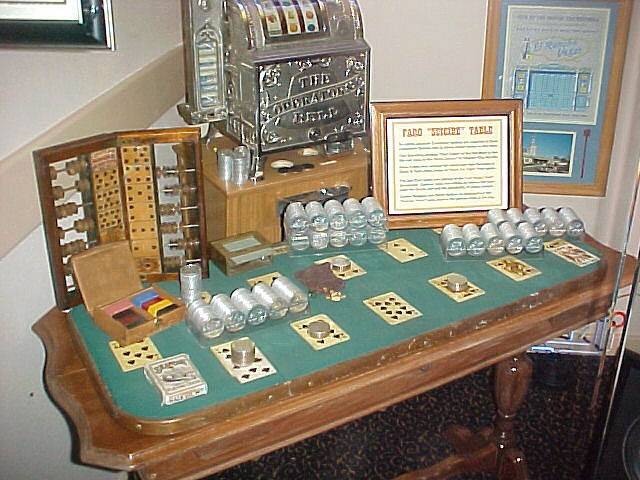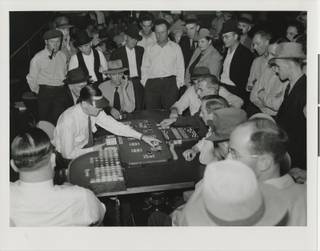
UNLV Libraries, Special Collections
This faro table, an old-time card game, was known as the “suicide table” since three of those who owned the table committed suicide after incurring heavy gambling debt. The table is on display at the Las Vegas Historic Museum at the Tropicana. Photo courtesy of the Las Vegas Historic Museum
Monday, Nov. 19, 2012 | 2 a.m.
Faro featured in 1993 film 'Tombstone'
Playing faro
(From Bicycle Cards' faro rules)
The faro table layout featured 13 playing cards, from ace to king, either glued, laminated or painted on felt, face up.
Bets were physically placed on the card or cards the players wanted to win. They also could place a small “copper,” or penny, on a card to bet on the losing card. Or they could split their bets between cards or bet on the high card.
A box was used to deal two cards face up, with a spring inside that pushed the deck to the top. The first card dealt was the losing card. The second was the winning card. Bets were paid or collected after each deal of the losing and winning cards.
A “casekeeper” would keep track of which cards were played on a small abacus-like device.
At the end of the deck, players would “call the turn” by betting the order of the remaining three cards. If they get the order right, the dealer would pay 4-to-1 odds.
When Wyatt Earp and Doc Holliday holstered their six-guns and sat down at a frontier saloon to gamble, they wouldn’t play poker.
The hot game of the Old West was called faro, or farobank. Earp dealt a game at the Oriental saloon in Tombstone, Ariz. Down the street, Doc Holliday picked up extra money as a dealer in the Bird Cage saloon.
Gamblers loved it. The hands played fast. A lot of people could play at once, like modern-day craps and roulette. And a smart player could make a fortune “bucking the tiger” — an animal often associated with the game — as the house had only a razor-thin edge.
But if you go to a Las Vegas casino today, don’t bother trying to find a faro game. The only faro table you’re likely to see here is at the Clark County Museum.
“There wasn’t enough of an edge for the house. So a lot of the casinos just started going away from it,” said Mark Hall-Patton, museum administrator. “They could make more on slot machines and other games.”
David Schwartz, director of UNLV’s Center for Gaming Research, said gamblers coming to Las Vegas after World War II were more familiar with craps, which they played in the armed forces. So craps became king.
Some of the city’s more famous gamblers, however, continued to play faro at downtown casinos into the late 1950s and early 1960s.
Faro was Nick “the Greek” Dandolos’ favorite casino game because it had the lowest house percentages, Hall-Patton said. A profile of Dandolos on pokernews.com says he once played farobank for 40 hours at the Golden Nugget.
Michael Gaughan, owner of South Point, remembers as a teenager watching Dandolos and other gamblers play faro at the Las Vegas Club, then owned by Gaughan’s father, Jackie Gaughan.
The last place Gaughan remembers that offered the game was the frontier-themed Bonanza Hotel and Casino, which was on the Strip where Bally’s is today, during the 1960s or early 1970s. Gaughan also remembers the Stardust having the game in the 1970s.
The last place on record running faro games in Las Vegas was the Bingo Palace, now Palace Station, in 1978 or 1979.
“It was a single table, adjacent to the pit area,” said Jim Edwards, who retired in 2010 as the senior agent and the training coordinator for the Nevada Gaming Control Board’s enforcement division. The faro table at the Bingo Palace was open only in evenings and on weekends, he said.
The only other working table Edwards saw after that was in Reno, at the Ramada, which had a faro table until 1985.
You can try your hand at faro for fun at the Wichita Faro website operated by Sean Gleeson, an Oklahoma City gaming programmer who built the game for fun to demonstrate his programming skills.
Gleeson said he tried to get local gaming manufacturer IGT and other companies interested in turning it into an electronic casino game, but nobody was interested. They said because it wasn’t an original game, there was no way to license it, Gleeson said.
The heyday for faro was during the California gold rush, Edwards said. It also was played extensively in Nevada after the discovery of the Comstock Lode in 1859 near Virginia City.
“The problem with faro is it lent itself quite easily to cheating,” Edwards said.
When there were high-limit games for tens of thousands of dollars in Virginia City, there was always a concern about the game being dishonest. The box used to deal the cards could be rigged to misdeal the cards, he said.
Players became so concerned about cheating from a gaffed box, they would instead put the deck in the middle of the table and drive a nail through it. The players would then tear off the cards one at a time — which meant they would go through a lot of decks, Edwards said.
Gaughan said the game has run its course.
“You’ll never see a live faro game in your lifetime,” he said.


Join the Discussion:
Check this out for a full explanation of our conversion to the LiveFyre commenting system and instructions on how to sign up for an account.
Full comments policy